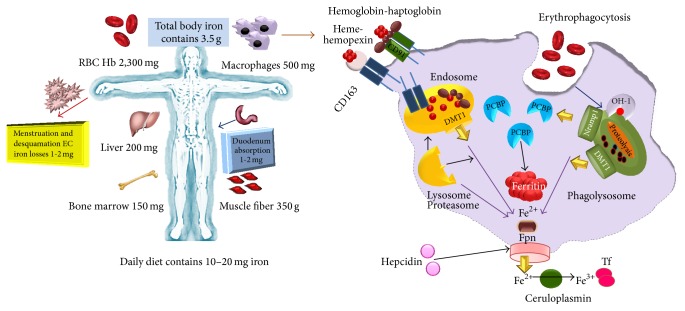Figure 1.
Iron content in the human body and iron-containing proteins in a macrophage. The average male adult contains approximately 3.5 g of iron. Approximately 2 g of iron is in hemoglobin: 1 g in body is stored predominantly in the liver and the rest in myoglobin and other iron-containing proteins. Approximately 1 to 2 mg of iron is lost each day by epithelial shedding in the gastrointestinal tract and the skin and through blood loss in menstruating women. Western diets contain a much greater amount of iron (10 to 20 mg) than what is absorbed daily under normal circumstances (1 to 2 mg). The macrophage is a key agent in iron homeostasis as well as in inflammatory hypoferremia. Macrophages in the spleen and in the liver (Kupffer cells) and perhaps elsewhere recognize damaged or senescent erythrocytes, phagocytize them, and digest them to extract heme and eventually iron. Macrophages can also scavenge heme and hemoglobin, usually complexed with hemopexin and haptoglobin, respectively, and endocytosed by CD163 and CD91, respectively. Whether phagocytosed in erythrocytes or endocytosed by scavenging, hemoglobin undergoes proteolysis to release heme. Heme is degraded by HO-1 to release iron, which is exported to the cytoplasm by DMT1 and probably also by Nramp1. Cytoplasmic chaperones family deliver iron for storage in the protein ferritin. Alternatively, iron from endosomes or phagolysosomes may also be delivered by an unknown carrier to ferroportin (Fpn) for export [20].

